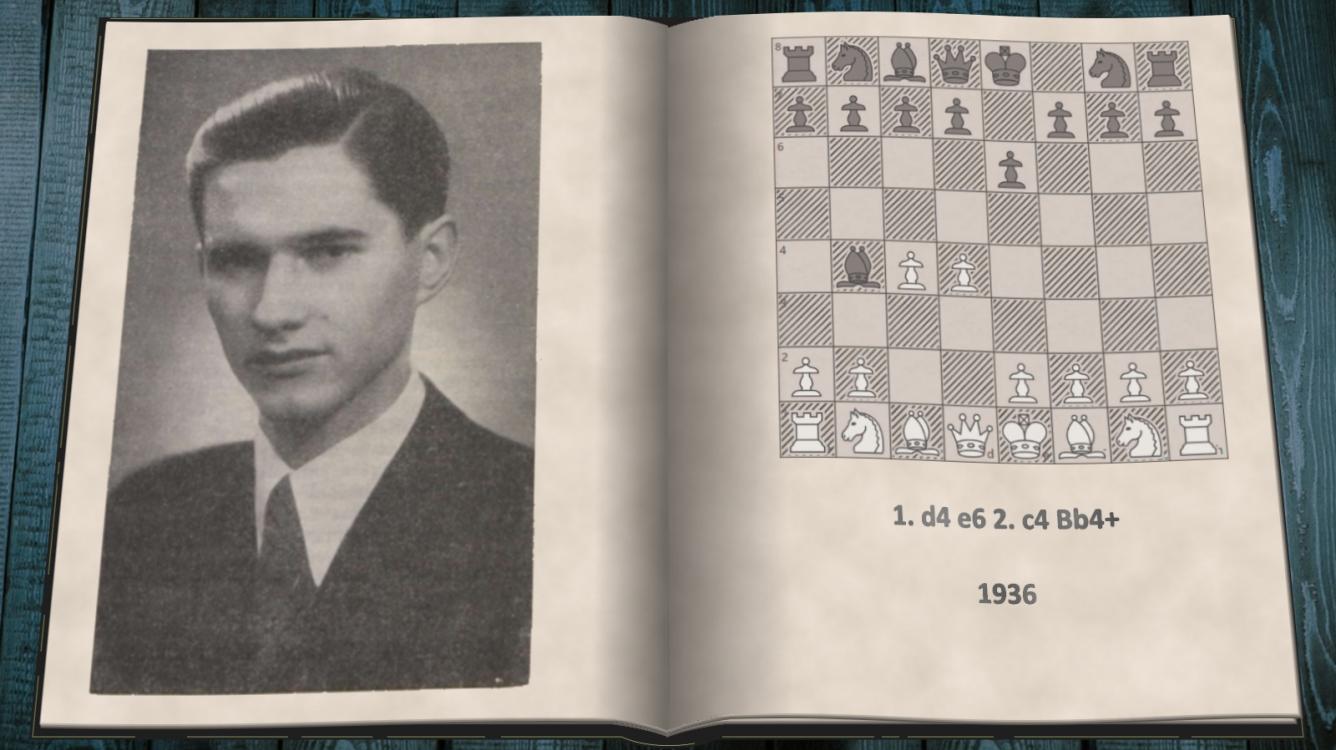
When Keres was playing 2... Bb4+
I hope that an illusion occurred and the thumbnail pamphlet was thought to be real for two seconds! Just took me some time to make it. Anyway...
Paul Keres, born in 1916 in Estonia, started to be considered a world class chess player in the mid 1930s. First time Estonian champion in 1935, he participated afterwards in many great and big chess tournaments till the war reached his country. Just to mention some of his wins: Bad Nauheim 1936 with Alekhine, his first international success, gold medal [1st board] within the unofficial chess Olympiad of Munich 1936, Margate 1937 with Fine, Semmering/Baden 1937, silver medal [1st board] within Stockholm 1937 Olympiad, AVRO 1938 with Fine, Margate 1939, Euwe - Keres 1939/40 Match. During these years he had also been the editor of Eesti Male, an Estonian chess magazine.

A star was rising and I think that maybe was a war victim to a degree. His pure talent had to be confined, due to the circumstances. As many of course. But Keres during 1935-40 was the young pure talent. However chess maybe saved his life during WW2. Or at least helped him live.
Since Sep 1939 and after a signed treaty, Soviet Union acquired the right to retain military forces in the Estonia land, and since Aug 6, 1940, Estonia was annexed by the SU. Keres participated in the USSR championship of 1940 & the Absolute of 1941. But since Sep 1941, after the invasion of the Nazis, the major part of Estonia was controlled by the Germans. Keres had the opportunity to leave I think, but he didn't. As also didn't leave Estonia during the Nazi occupation. It's my feeling that he wanted to have a normal life despite the circumstances, as one can understand by the fact that Keres married and became father of two children during these hard years.

A thing that I wasn't aware of is that Keres probably became a nazi propaganda victim. In Revaler Zeitung of Mar 5, 1942 [a german speaking newspaper of Tallinn], an article was published where few Keres' words were said to be reproduced around the life in Soviet Union and the Jews. Just check the title for a clue:
| German text | google translation |
|
Der "beschattete" Schachmeister Paul Keres über seine Erlebnisse in der Sowjetunion. Reval, 4. März Der estnische Schachmeister Paul Keres gekörte zu den wenigen Esten, die Einblick in das "Sowjetparadies“ gewannen und später wieder in ihre Heimat zurückkehren konnten. Über seine Eindrücke berichten wir im fol genden: |
The "shadowed" chess master Paul Keres about his experiences in the Soviet Union. Reval, 4 March The Estonian chess champion Paul Keres was one of the few Estonians who gained insight into the "Soviet paradise" and later returned to their homeland. We report on his impressions in the following: |
_
The later Soviet behavior towards Keres I think that proves beyond doubt that these weren't actually believed as the Keres' true words or/and feelings. However Keres few days afterwards started to write regularly the chess and crossword column of Postimees, an Estonian daily newspaper, activity that was his main income during the Nazi occupation. It took a while but in the end he participated in German-Nazi organized tournaments, since 1942. Although he refused a championship match against Alekhine!
_
1. d4 e6 2. c4 Bb4+
I knew that Keres was a Nimzo Indian player as black against 1. d4. However during his first successful years, he followed sometimes an alternate move sequence, tried already few times before, but now bearing the name Keres' Defense, as was played mostly by him and successfully [from the 20 games I've found by Keres the record is +8-4=8]. 1. d4 e6 2. c4 Bb4+...
Depending on the forced white's third move, this opening can be transformed into Nimzo Indian if white plays 3. Nc3 and into Bogo Indian if white chooses 3. Bd2. Nevertheless, 3. Bd2 can be also the start for alternate opening lines, that borrow moves from the previously mentioned ones but that should be still considered as only Keres Defense, I think. There's also the rare case of 3. Nd2.

He firstly tried it in a match against Paul Schmidt during May 1936, where an alternative followed, an early pawn capture. Generally checking Keres' games, one of the lines that I noticed him trying was to take advantage of the unmoved king's N so to play an early f5, leading to Dutch-Nimzo setups [but without a previous black's Ne4]. So here're three different continuations...
_
Transforming into Nimzo Indian. Against Landau withing Zandvoort 1938
_

_

_
Keres Defense with f5. Dutch defense color against Frydman within Munich Olympiad 1936
_

Transforming into Bogo Indian - Nimzowitsch Variation. Against Stahlberg within Stahlberg - Keres 1938
_

_
3. Bd2 a5
A more modern and interesting approach of the Keres Defense that actually retains a more unique character. Just a game I've liked without comments...
_
_
....thanx for reading

